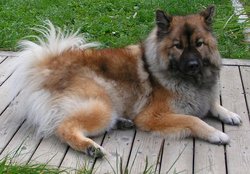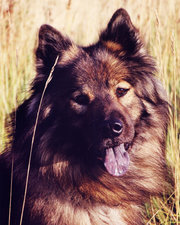The Eurasier, sometimes referred to as the Eurasian, is a breed of dog that is relatively unknown in America, but in Europe it is widely known as a wonderful companion that maintains his own personality, has a dignified reserve to strangers, a strong bond to its family and that is relatively easy to train.
Appearance
The Eurasier is a balanced, well-constructed, medium-sized Spitz (Spitzen) type dog with prick ears. It comes in different colors: fawn, red, wolf-grey, black, and black and tan. All color combinations are allowed, except for pure white, white patches, and liver color. Fédération Cynologique Internationale (FCI) standards call for the Eurasier to have a thick undercoat and medium-long, loosely lying guard hair all over the body, with a short coat on the muzzle, face, ears, and front legs. The tail and the back of the front legs (feathers) and hind legs (breeches) should be covered with long hair. The coat on the Eurasier's neck should be slightly longer than on the body, but not forming a mane. The breed may have a pink, blue-black or spotted tongue.
The male has a height of 52 to 60 cm (20-24 inches) at the withers and weighs approximately 23 to 32 kg (50-70 lbs).
The female has a height of 48 to 56 cm (16-18 inches) at the withers and weighs anywhere from 18 to 26 kg (40-60 lbs).
Temperament
Eurasiers are calm, even-tempered dogs. They are watchful and alert, yet reserved towards strangers without being timid or aggressive. Eurasiers form a strong link to their families and are fond of children. For the full development of these qualities, the Eurasier needs constant close contact with its family, combined with understanding, yet consistent, training. They are extremely sensitive to harsh words or discipline and respond best to soft reprimand. The Eurasier is a combination of the best qualities of the Chow Chow, the Wolfspitz, and the Samoyed, resulting in a dignified, intelligent breed.
Eurasiers are not suitable as working dogs. Training should always be done through family members, not through strangers or handlers. Eurasiers should never be restricted to only a yard, kennel, crate, or chained up. They would pine and become depressed. This breed enjoys all kinds of activities for all the family, e.g. agility. Eurasiers are calm and quiet indoors, outdoors they are lively and enjoy action.
History
Eurasiers originated in Germany in 1960, when the founder, Julius Wipfel, set out together with Charlotte Baldamus and a small group of enthusiasts to create a breed with the best qualities of the Chow-Chow and the Wolfspitz. The initial combination of the breeds resulted in what was first called "Wolf-Chow" and then, twelve years later, after crossing with a Samoyed, was renamed "Eurasier" (Eurasian) and recognized by the FCI in 1973. Nobel Laureate Konrad Lorenz obtained a Eurasier puppy from Charlotte Baldamus, Nanette vom Jaegerhof, whom he called "Babett". He thought her character was the best he had ever known in a dog.
Read more at Wikipedia.org




